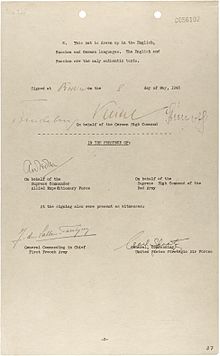| The capitulation of the German state to the conditions provided by the Allies | |
|---|---|
 Field-Marshal Wilhelm Keitel signing the unconditional surrender document, 8 May 1945 | |
| Type | Capitulation |
| Signed | 8 May 1945 |
| Location | Berlin, Germany |
| Condition | Signed |
| Signatories | |
| Parties | |
| Ratifiers |
|
| Full text | |

The German Instrument of Surrender[a] was a legal document effecting the unconditional surrender of the remaining German armed forces to the Allies, ending World War II in Europe. It was signed at 22:43 CET on 8 May 1945[b][citation needed] and took effect at 23:01 CET on the same day.
The day before that, Germany had signed another surrender document close to it with the Allies in Reims in France, but it was not recognized by the Soviet Union for enforcement, so another document was needed to sign; and in addition, immediately after signing the German forces were ordered to cease fire in the west and continue fighting in the east. Germany under the Flensburg Government led by the head of state, Grand-Admiral Karl Dönitz, also accepted the Allied suggestion to sign a new document. The document was signed at the seat of the Soviet Military Administration in Germany (Karlshorst, Berlin) by representatives from the German "Oberkommando der Wehrmacht" (OKW),[c] the Allied Expeditionary Force represented by the British, and the Supreme High Command of the Soviet Red Army, with further French and American representatives signing as the witnesses. This time, Field-Marshal Wilhelm Keitel was the highest representative of Germany at the signing ceremony. This surrender document of Germany also led to the de facto fall of Nazi Germany. As one result of Nazi German downfall, the Allies had de facto occupied Germany since the German defeat – which was later confirmed via the Berlin Declaration by the four countries of Allies as the common representative of new Germany (France, USSR, UK and the US), on 5 June 1945.
There were three language versions of the surrender document – English, Russian, and German – with the English and Russian versions proclaimed in the document itself as the only authoritative ones.
Cite error: There are <ref group=lower-alpha> tags or {{efn}} templates on this page, but the references will not show without a {{reflist|group=lower-alpha}} template or {{notelist}} template (see the help page).